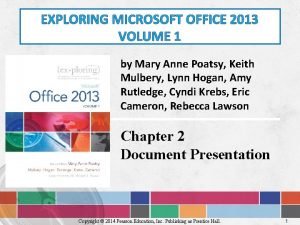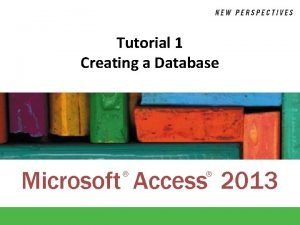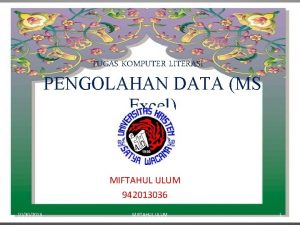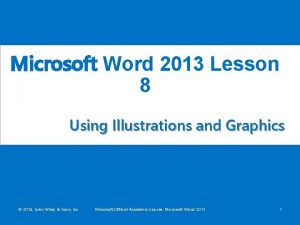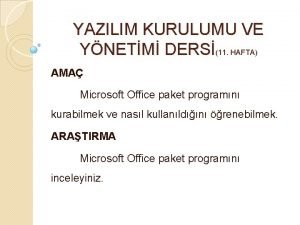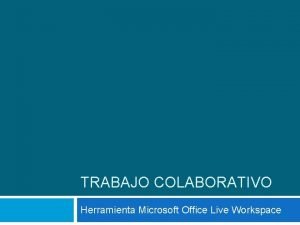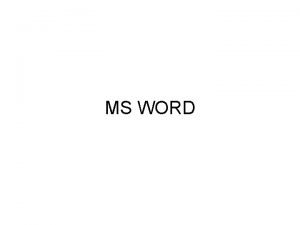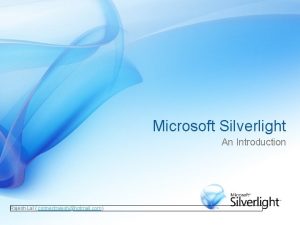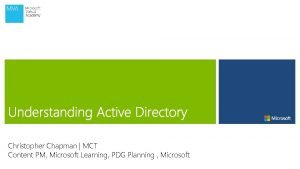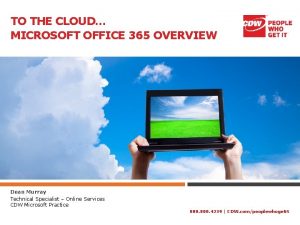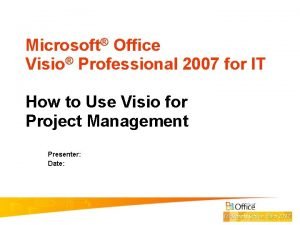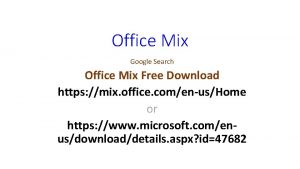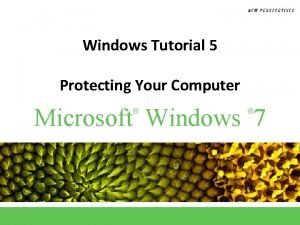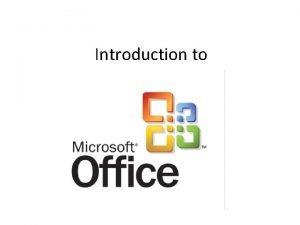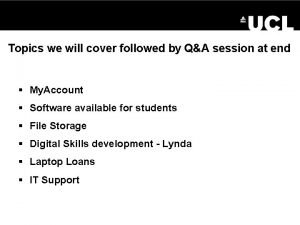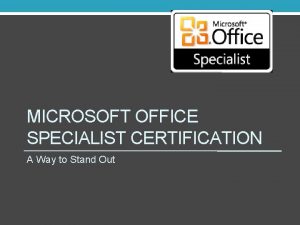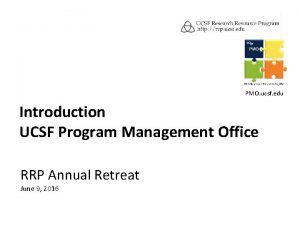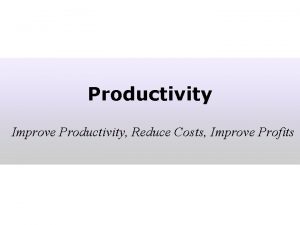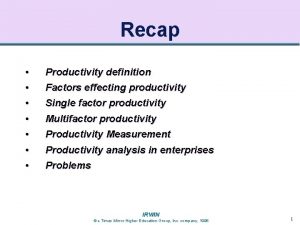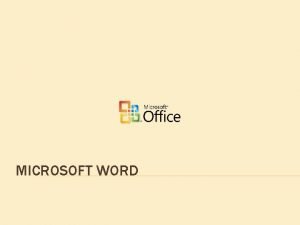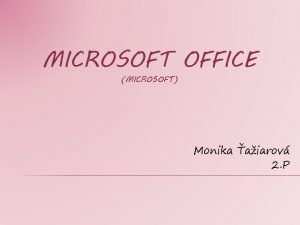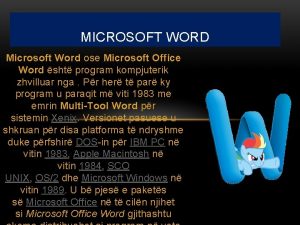Office 2013 Microsoft Office 2013 is a productivity


























































- Slides: 58

Office 2013 Microsoft Office 2013 is a productivity suite of applications. In this section: Common Application Components, Working with Files and Documents, Common Editing Functions, Common Formatting Functions, Working with Graphics, Working with Tables, Printing & Publishing, Sharing Content Between Applications, Collaborating with Office 2013 and Customizing Office Applications. Skills > Office 2013

Common Application Components Microsoft Office® 2013 is a complete suite of productivity software applications that includes Word, Excel, Power. Point, Access, and other applications such as One. Note and Outlook. The software suite is designed to support both personal and professional communications, presentations, financial decision making, data collection and analysis, reporting, publishing, and much more. In this section: Launching Applications, Application Components, Ribbons and Tabs and Getting Help. Skills > Office 2013 > Common Application Components

Launching Applications To start, or launch, a Microsoft Office application, right-click any blank space on the Start screen to bring up the apps bar. To launch any application, just point and click its icon. Apps bar with All apps icon Skills > Office 2013 > Common Application Components > Launching Applications

Application Components Quick Access Toolbar, upper left corner of all Office applications, gives easy access to frequently used features. Upper-right corner of Word window contains Minimize, Restore Down, and Close buttons. Skills > Office 2013 > Common Application Components > Application Components

Application Components The Zoom slider allows you to magnify or shrink the content displayed in the active window. You can zoom in to get a closeup view of your file or zoom out to see more of the page at a reduced size. You can also save a particular zoom setting with a document or template, presentation, or worksheet. Skills > Office 2013 > Common Application Components > Application Components

Ribbons and Tabs Every application in Office 2013 has a Ribbon across the top. You can click the tabs at the top of the Ribbon to display different sets of tools. Clicking the File tab opens Backstage View. Skills > Office 2013 > Common Application Components > Ribbons and Tabs

Ribbons and Tabs You can click a group’s Dialog Box Launcher to open a smaller window, called a dialog box, where you can adjust settings related to that group. Skills > Office 2013 > Common Application Components > Ribbons and Tabs

Getting Help Built into Office 2013 are two main ways of getting information about features and tasks: Screen. Tips and the Help window. Skills > Office 2013 > Common Application Components > Getting Help

Working with Files & Documents The videos in this section are designed to help you open, navigate, and save documents created in Office 2013. In this section: Creating New Files From Scratch or Templates, Opening an Existing File, Navigating in a Document, Document Views and Zoom, Switching Between Open Documents, Saving and Closing Documents. Skills > Office 2013 > Working with Files and Documents

Creating New Files from Scratch or Templates To create a new, blank document, click the button on the right. Another option is to create a document based on a template. A template is a file that includes predefined text and design elements. Skills > Office 2013 > Working with Files and Documents > Creating New Files from Scratch or Templates

Opening an Existing File To open existing files from the File tab, you can either: § Select recently opened documents § Open (browse) or Open Other Documents Skills > Office 2013 > Working with Files and Documents > Opening an Existing File

Navigating in a Document To move around, or navigate, in a document, you can use the built-in Navigation pane. Skills > Office 2013 > Working with Files and Documents > Navigating in a Document

Document Views and Zoom Word has three views: § Read Mode § Print Layout § Web Layout Skills > Office 2013 > Working with Files and Documents > Document Views and Zoom

Switching Between Open Documents To switch to a document, move the mouse over the Word 2013 icon in the bottom taskbar and click the document’s thumbnail. Skills > Office 2013 > Working with Files and Documents > Switching Between Open Documents

Saving and Closing Documents To save a document that you’ve never saved before, click Save in Quick Access toolbar. To save a file with a new name or in a new location, click File tab, and then Save As. Skills > Office 2013 > Working with Files and Documents > Saving and Closing Documents

Common Editing Functions The video lessons in this section are designed to help you better understand common editing functions in Office 2013. These functions will make it easier for you to create and edit well-written and error-free documents. In this section: Selecting, Inserting and Deleting Text, Mini Toolbar and Quick Access Toolbar, Inserting and Editing a Hyperlink, Using Copy/Cut/Paste, Find and Replace, Spelling and Grammar Check. Skills > Office 2013 > Common Editing Functions

Selecting, Inserting & Deleting Text To select text, press and hold down the left mouse button, drag the mouse pointer over the text, and then release the mouse button. To replace selected text with new text, just type. Skills > Office 2013 > Common Editing Functions > Selecting, Inserting and Deleting Text

Mini Toolbar & Quick Access Toolbar In each Office application, the Mini toolbar contains frequently used tools. The Quick Access tool-bar is located in upper left corner of screen in all Office applications. You can customize the Quick Access toolbar to add buttons that are most useful for you. Skills > Office 2013 > Common Editing Functions > Mini Toolbar and Quick Access Toolbar

Inserting and Editing a Hyperlink The Insert Hyperlink dialog box allows you to create different kinds of links: § Existing File or Web page § Place in This Document To change the web address associated with a hyperlink, right-click the hyperlink to open a Shortcut menu and then click Edit Hyperlink. In the Edit Hyperlink dialog box, you can type a different web address Skills > Office 2013 > Common Editing Functions > Inserting and Editing a Hyperlink

Using Copy/Cut/Paste Copy an item to the Office Clipboard to add it to your collection, and then paste it from the Office Clipboard into any Office document at any time. Skills > Office 2013 > Common Editing Functions > Using Copy/Cut/Paste

Find and Replace Finding and replacing text is a timesaving skill, especially for lengthy documents. The tools you need are located in the Editing group on the Home tab. The Navigation pane displays all instances of the phrase. Skills > Office 2013 > Common Editing Functions > Find and Replace

Spelling and Grammar Check A wavy red line indicates spelling mistakes. A wavy blue line indicates contextual spelling errors. Readability statistics show document’s word count, words per sentence, and reading grade level. Skills > Office 2013 > Common Editing Functions > Spelling and Grammar Check

Common Formatting Functions The video lessons in this section are designed to show you how to use common Office functions to preview changes before applying them (Live Preview), change and format fonts, select line and paragraph spacing, create numbered or bulleted lists, and copy selected formats to “paint” them on other parts of your documents. These skills can help you dress up your documents so they have a consistent appearance. In this section: Galleries with Live Preview, Working with Fonts, Paragraph Formatting, Working with Lists and Using the Format Painter Skills > Office 2013 > Common Formatting Functions

Galleries with Live Preview In Office 2013, galleries, palettes, and live previews make it easy to see how your file will be altered by a choice you make from one of the tools in the Ribbon. Skills > Office 2013 > Common Formatting Functions > Galleries with Live Preview

Working with Fonts By default, when you start typing, the text or numbers are formatted in the Calibri font. Fonts are measured in points, with one point equal to 1/72 of an inch. You can move the mouse pointer over an option to see a live preview. Skills > Office 2013 > Common Formatting Functions > Working with Fonts

Paragraph Formatting To turn on non-printing characters, click Show/Hide button. Choices for aligning text in a paragraph include Left, Center, Right, or Justify. The Line and Paragraph Spacing button reveals choices for spacing between lines of text and between paragraphs. Skills > Office 2013 > Common Formatting Functions > Paragraph Formatting

Working with Lists The Paragraph Group on the Home tab has three options for working with lists: § Bullets § Numbering § Multilevel List Skills > Office 2013 > Common Formatting Functions > Working with Lists

Using the Format Painter The Format Painter is useful for copying formatting, such as bold, italics, or fonts, from one place and applying it to another. The Format Painter button turns blue to indicate it’s selected. To copy formatting to multiple locations, select the text with formatting to copy, doubleclick the Format Painter button, and then drag the paintbrush pointer as necessary. Skills > Office 2013 > Common Formatting Functions > Using the Format Painter

Working with Graphics The video lessons in this section are designed to show you how the use of clip art, photos, illustrations, and other graphics can add visual appeal to your documents. Try out the techniques shown in these videos on your own art and photos to see how well Office 2013 enhances your personal creativity. In this section: Inserting Pictures, Inserting Shapes and Word. Art, Capturing Screenshots, Applying Graphics Effects and Editing Photos. Skills > Office 2013 > Working with Graphics

Inserting Pictures Use the tools in the Illustrations group on the Insert tab to insert pictures from a variety of sources. Skills > Office 2013 > Working with Graphics > Inserting Pictures

Inserting Shapes and Word. Art Use the Shapes button in the Illustrations group on the Insert tab to add shapes to an Office file. Shapes are also known as drawing objects or drawn objects. You can modify the size, rotation, alignment, and style. Skills > Office 2013 > Working with Graphics > Inserting Shapes and Word. Art

Capturing Screenshots The Screenshot button is in the Illustration group on the Insert tab. You can modify a selected screenshot by using the buttons on the Picture Tools Format tab. A screenshot is a picture of an application window. Skills > Office 2013 > Working with Graphics > Capturing Screenshots

Applying Graphic Effects You can enhance the appearance of a graphic by applying effects. There are two kinds of effects – picture effects, which change the edges of a picture, and artistic effects, which change the image itself. Skills > Office 2013 > Working with Graphics > Applying Graphic Effects

Editing Photos In addition to applying effects and styles to graphics, you can edit a photo in many ways: remove background; crop; adjust focus, contrast, and brightness; and adjust color. Skills > Office 2013 > Working with Graphics > Editing Photos

Working with Tables The video lessons in this section are designed to help you create and format tables within documents. Tables in Word are different from those found in Excel and Access, yet they still offer users a similar way to organize, sort, and use the contents stored in them. If you’ve never created a table inside a document before, be sure to watch these lessons. Tables are a good way to organize text or numerical data. In this section: Creating a Table, Adjusting Rows, Columns, and Cells and Sorting/Formatting Tables. Skills > Office 2013 > Working with Tables

Creating a Table § Create a table § Add text to a table § Move to the next cell with the Tab key § Convert text to a table § Delete a table Skills > Office 2013 > Working with Tables > Creating a Table

Adjusting Rows, Columns, & Cells After you create a table, you can adjust the rows, columns and cells to better fit the data by: § Inserting rows and columns § Adjusting column widths and row heights § Merging and splitting cells Skills > Office 2013 > Working with Tables > Adjusting Rows, Columns, and Cells

Sorting and Formatting Tables In the Sort dialog box, you can specify how you want to sort the data. By default, Word sorts the table according to the contents of the column on the left. Also by default, it sorts the data in ascending, or alphabetical, order. Skills > Office 2013 > Working with Tables > Sorting and Formatting Tables

Printing & Publishing You can avoid printing unnecessary amounts of paper if you take the time to prepare your documents. If you’ve never created a PDF document from a Word document before, be sure to pay particular attention to that video lesson, especially if you’ll be sharing them with people who may not use the same version of Office or when you want to create a non-editable version of your document to print or post on a website. In this section: Formatting Documents for Printing, Previewing Documents, Specifying Print Options, Managing Print Jobs, Printing to PDF, Emailing or Faxing Documents. Skills > Office 2013 > Printing and Publishing

Formatting Documents for Printing Before printing any document, it’s a good idea to use the options in the Page Layout tab to make sure the document prints the way you want it to look. The Page Setup group on the Page Layout tab holds several tools related to formatting the entire page. Skills > Office 2013 > Printing and Publishing > Formatting Documents for Printing

Previewing Documents Before printing any document, it’s a good idea to preview it to confirm it appears as you intend it to look. Click the File tab to open Backstage View. Then click Print. A preview of the printed document appears on the right. Skills > Office 2013 > Printing and Publishing > Previewing Documents

Specifying Print Options You can specify Print options, including: § Number of copies to print § Printer to print to § Number of pages to print § Two-sided printing § Collated pages Skills > Office 2013 > Printing and Publishing > Specifying Print Options

Managing Print Jobs The Print options on the File tab offer many ways to manage print jobs. Skills > Office 2013 > Printing and Publishing > Managing Print Jobs

Printing to PDF Saving a file to a PDF is a great way to package your work so it appears and prints exactly as you want it to look when others view it. This is also known as printing to a PDF. Skills > Office 2013 > Printing and Publishing > Printing to PDF

Emailing or Faxing Documents It’s easy to send a document as an email attachment or fax. Skills > Office 2013 > Printing and Publishing > Emailing or Faxing Documents

Sharing Content Between Applications The video lessons in this section are designed to help you understand how to successfully copy content between Office 2013 applications and how to link and embed objects within documents and files. All three lessons focus on integration so you can make the most of Office’s ability to copy, link, and embed content across different software programs when creating documents for school, home, or work. In this section: Copying Content Between Applications, Object Linking, Embedding and Integration Examples. Skills > Office 2013 > Sharing Content Between Applications

Copying Content Between Applications Microsoft Office 2013 makes it easy to copy data in one file and paste it into another file in a different application. Skills > Office 2013 > Sharing Content Between Applications > Copying Content Between Applications

Object Linking & Embedding When working with information that appears in two or more files, the best way to make sure the information is consistent between the files is to use Object Linking and Embedding (OLE). Embedding: 1) Copy information in source file 2) Paste in destination file 3) To edit information within the destination file, double-click to display tools of source program 4) No connection between source file and destination file Skills > Office 2013 > Sharing Content Between Applications > Object Linking and Embedding Linking: 1) Creates a connection between destination and source files 2) Changes in source file show up in destination file

Collaborating with Office 2013 The video lessons in this section are designed to acquaint you with all the options now available for sharing files. By using Microsoft’s One. Drive and a Window’s Live account, adding electronic “sticky notes, ” tracking and accepting or rejecting the changes made by various users, and combining documents from different users into a single merged document. In this section: Sharing Documents, Adding Comments, Tracking Changes, Accepting or Rejecting Changes, Comparing and Merging Documents and Protecting Documents. Skills > Office 2013 > Collaborating with Office 2013

Sharing Documents Microsoft offers a variety of cloud computing tools for helping groups collaborate, no matter where group members are located, including Share. Point and Microsoft’s live. com service. Skills > Office 2013 > Collaborating with Office 2013 > Sharing Documents

Adding Comments When sharing documents, it’s often necessary to include notes to other readers. In Office 2013, you can do this by adding comments to a document. Skills > Office 2013 > Collaborating with Office 2013 > Adding Comments

Tracking Changes The Review tab contains options related to tracking changes. All the buttons you need are in the Tracking group. Skills > Office 2013 > Collaborating with Office 2013 > Tracking Changes

Accepting or Rejecting Changes When you’re working on a document that contains tracked changes, you can choose to accept or reject the changes. Skills > Office 2013 > Collaborating with Office 2013 > Accepting or Rejecting Changes

Comparing & Merging Documents As files are revised, they often need to be compared and merged, or combined, into a single file. The most recent changes get added and saved before more changes are made. Skills > Office 2013 > Collaborating with Office 2013 > Comparing and Merging Documents

Protecting Documents Protection settings in Backstage view include: § Mark Final § Encrypt with Password § Restrict Editing § Restrict Access § Add Digital Signature Skills > Office 2013 > Collaborating with Office 2013 > Protecting Documents

Customizing Office Applications The video lessons in this section are designed to acquaint you with the different ways you can customize the Ribbon, create your own tabs on the Ribbon, and work with the Options found in the File tab’s Backstage view. In this section: Customizing Ribbons, Tabs, Toolbars and Application Options. Skills > Office 2013 > Customizing Office Applications

Customizing Ribbons, Tabs, & Toolbars You can customize the Ribbon by rearranging the tab order or even creating your own new tab. Skills > Office 2013 > Customizing Office Applications > Customizing Ribbons, Tabs, and Toolbars

Application Options Every Office 2013 application has an Options dialog box where you can adjust numerous settings for that application. The available options vary from one Office application to another. Skills > Office 2013 > Customizing Office Applications > Application Options
 Exploring microsoft office 2013 volume 1
Exploring microsoft office 2013 volume 1 Woven mat texture fill in excel
Woven mat texture fill in excel Ms access 2013 tutorial
Ms access 2013 tutorial Microsoft access 2013
Microsoft access 2013 Uraikan tentang efektivitas rumus pada microsoft excel 2013
Uraikan tentang efektivitas rumus pada microsoft excel 2013 Clip art microsoft word 2013
Clip art microsoft word 2013 Office 2013 sistem gereksinimleri
Office 2013 sistem gereksinimleri Microsoft excel merupakan progran aplikasi…
Microsoft excel merupakan progran aplikasi… Microsoft official academic course microsoft word 2016
Microsoft official academic course microsoft word 2016 Microsoft official academic course microsoft word 2016
Microsoft official academic course microsoft word 2016 Microsoft official academic course microsoft excel 2016
Microsoft official academic course microsoft excel 2016 Microsoft startwarren theverge
Microsoft startwarren theverge Docker microsoft office
Docker microsoft office Office microsoft
Office microsoft Exploring microsoft office excel 2016 comprehensive
Exploring microsoft office excel 2016 comprehensive Herramienta de microsoft office live
Herramienta de microsoft office live Microsoft office seminar
Microsoft office seminar Ams.unt.edu
Ams.unt.edu Microsoft epm
Microsoft epm Cunyfirst microsoft office
Cunyfirst microsoft office Ms word nedir
Ms word nedir Silverlight seminar ppt download
Silverlight seminar ppt download Microsoft office
Microsoft office Solidworks
Solidworks Boston university microsoft office
Boston university microsoft office Lembar kerja program aplikasi pengolah angka adalah…. ?
Lembar kerja program aplikasi pengolah angka adalah…. ? Microsoft office
Microsoft office Microsoft pdg
Microsoft pdg Boston university bursar office
Boston university bursar office Chan park microsoft
Chan park microsoft Microsoft dynamics gp compliance automation
Microsoft dynamics gp compliance automation Lars bjørnshauge
Lars bjørnshauge Microsoft office project 2007
Microsoft office project 2007 Httpoffice
Httpoffice Chapman microsoft office
Chapman microsoft office Offico365
Offico365 Visio office 2007
Visio office 2007 Microsoft office 2007 wikipedia
Microsoft office 2007 wikipedia Exploring microsoft office xp
Exploring microsoft office xp Download office mix
Download office mix Microsoft office privacy settings popup
Microsoft office privacy settings popup Emory microsoft office download
Emory microsoft office download Ukf microsoft office
Ukf microsoft office Microsoft office enterprise project management
Microsoft office enterprise project management Microsoft exchange
Microsoft exchange Project 2010 tutorial
Project 2010 tutorial Cmrt moodle
Cmrt moodle History microsoft office
History microsoft office помощь по microsoft office outlook
помощь по microsoft office outlook Desktop ucl anywhere
Desktop ucl anywhere Safeassign seneca
Safeassign seneca Ouhsc health club
Ouhsc health club Office automation microsoft dynamics gp
Office automation microsoft dynamics gp Met office microsoft climate
Met office microsoft climate Pdg microsoft
Pdg microsoft Dmu.vle
Dmu.vle Do microsoft office specialist certifications expire
Do microsoft office specialist certifications expire Ucsf microsoft office
Ucsf microsoft office Nau google drive
Nau google drive
